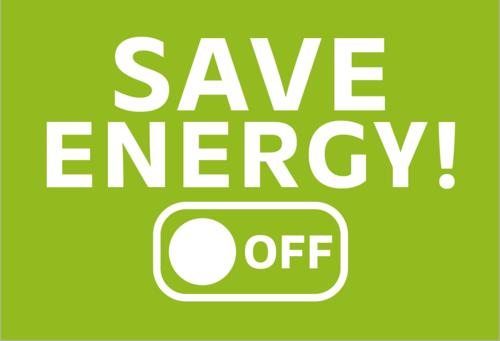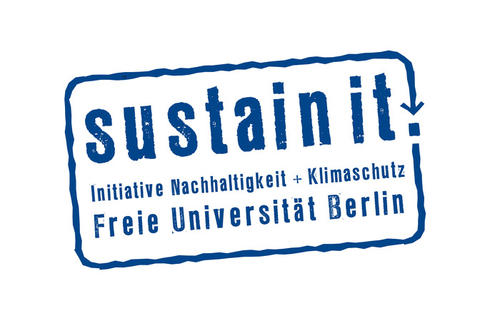Around Laboratories
In laboratories, ventilation, exhaust systems, and electrical devices consume 3-5 times more energy than in offices. There is also an increased demand for water and plastic. Your behavior can have a significant impact, reducing energy, water, and other resource consumption considerably.
Support your colleagues in using energy as needed by sharing these tips.
Typically, the largest energy consumers in the laboratory are hoods and ventilations, offering the greatest potential for savings.
Turn off hoods
Turn off the hood of the digestorium after finishing the experiment and storing hazardous substances in the hazardous material cabinet.
Reduce power consumption of hoods
The energy consumption of the digestorium hood depends on whether the front window is open or closed. While an open window exchanges about 600 m³ of air per hour, it is only about one-third with a closed window. Working with a semi-closed front window already helps to save energy.
Efficient operation of laboratory ventilation
Please keep laboratory doors and windows closed, as the energy consumption of laboratory ventilation is at its lowest when doors and windows are closed.
Energy-efficient storage of hazardous materials
Digestoriums should not be used as storage space for chemicals. Clear the hood after completing the experiment and place hazardous chemicals in hazardous material cabinets.
When the cabinets are full, please check if unused or outdated chemicals can be disposed of. All information on special disposal can be found here.
Save energy by choosing the hood
In many laboratories, laboratory ventilation is coupled with the ventilation of a digestorium. The ventilation in this digestorium cannot be turned off. Please inquire before starting the experiment which digestoria in your laboratory are continuously ventilated and preferably use these.
Set laboratory closing times
Inform your department administration about the night and weekend times when the laboratory is not in use. During this time, laboratory ventilation - except for hazardous material cabinets - can be minimized or turned off to a minimum in coordination with the Technical Department.
Storage of samples must be secure. Energy conservation should not jeopardize the safe storage of samples in freezers and refrigerators. Nevertheless, a responsible handling of chemicals can result in significant energy savings.
Minimize usage times
Open freezer units for as short a time as possible. Clear labeling saves time searching with the door open. Also, check during use whether the appliance closes properly. Examine whether the unit needs defrosting or if a replacement of the rubber seal is necessary.
Replace old freezer units
The technological progress in cooling and device insulation is impressive. For devices older than 15 years, replacement is (almost) always worthwhile. At the Sustainability & Energy Unit, you can borrow a measuring device to assess the power consumption of the refrigeration unit. Look for an energy-efficient new freezer with environmentally friendly refrigerant and compare the consumption. Replacement may be financially supported after examination by the Sustainability & Energy Unit if there is a savings of at least 30%.
Optimize cooling temperature
The practice of the last 10 years has shown that samples can be safely stored at -70°C. A freezing temperature of –80°C is generally not necessary. Such a temperature increase has already been implemented at Takustraße 6. Scientific studies confirm the efficiency and safety of this approach.
Optimize cooling duration
Samples can be stored at -70°C for over 5 years. Samples that are no longer needed should be destroyed. After 5 years, if longer storage is necessary, the samples can be moved to freezers at a temperature of -20°C. This saves energy and makes room for new samples.
Optimize cooling volume
Space in the freezer is valuable. Half-empty freezers are inefficient. Please use freezer space responsibly by optimizing packaging sizes, disposing of no longer needed samples, and turning off unused devices. Good record-keeping helps quickly locate empty compartments and sort out old samples.
In laboratory operations, numerous devices consume energy, such as laminar flow benches, autoclaves, dishwashers, drying ovens, water baths, incubators, and ice machines. Did you know that a single drying oven can incur €1,000 in electricity costs per year?
Reduce Standby Power Consumption
Many electrical devices continue to consume unnecessary power even in standby mode. To save energy, electrical devices should not only be turned off but also disconnected from the power grid when not in use or, at the latest, at the end of the workday or on weekends (unplug or use switchable power strips).
Use stickers to differentiate devices that may be turned off after each use or those that should remain connected to meet research parameters. Stickers are available from the Sustainability & Energy Unit.
The standby mode and screensavers of computers also consume a significant amount of energy. If workplace PCs are not used for more than 60 minutes, it is advisable to shut them down.
Pay attention to the rated power of the devices. But, particularly, the operating times of the devices are crucial!
|
Device |
Rated Power (Watt) |
|
Amino Acid Analyzer |
300 |
|
PC |
100 |
|
Monitor |
72 |
|
Autosampler |
250 |
|
Centrifuge |
300 |
|
Freezer |
400 |
Optimizing Device Usage
Electrical devices are particularly efficient when the size or power of the device is suitable for the task. Before starting experiments, check if lower-powered devices are available, possibly in other research groups. If it is foreseeable that many experiments must be conducted with oversized or suboptimal devices for the task, consider the possibility of acquiring new equipment.
Limit the Number of Devices
Create a list of available laboratory equipment and exchange information with other research groups in your institution or department. For portable devices, you can introduce a booking or borrowing system. For stationary devices, consider if it is possible to make workstations available to researchers from other labs. The list can help optimize the use of equipment in the institution or department when planning to purchase new laboratory equipment.
Reduce Computing Power
Can computing power be adjusted or reduced in complex computational operations? This saves energy. Research suitable software tools and their carbon footprint. Switching to other software versions can save up to 73% of CO2 emissions.
Work with Energy-Efficient Lighting
Always remember to turn off the lights when not needed or when the room is unoccupied.
Use exclusively LED light bulbs as they are particularly energy-efficient. If a switch to LED is not possible, consider purchasing new lighting. Even though LED bulbs may be more expensive, their acquisition is justified due to energy savings and long lifespan. For permanently installed lights, inform the technical staff and coordinate light bulb replacement with an electrician.
Proper Heating
Only heat as much as is truly needed. If you are frequently moving or have several devices running in the labs, the thermostat valve can be set to position 2.5 (approximately 19 °C). If you sit for long periods, consider setting it to level 3 (approximately 20 °C).
Turn the heating to position 0 when you open the windows for ventilation and only turn it up again when the windows are closed.
For the end of the workday, set the heating to position 2. A one-degree difference saves 5-6% of heating energy.
Close the doors to the corridors, as these should be heated as little as possible due to energy-saving regulations starting from September 1, 2022.
By reconsidering routines, a significant amount of energy can be saved.
- Please examine when and where you use a considerable amount of energy, resources, and water.
- Where is there potential for improvement? How can work processes be made more efficient? What are the obstacles? How can these obstacles be overcome?
- Can ventilation systems be turned off when work processes are adjusted?
- Can individual ventilation systems be permanently shut down by reaching an agreement on specific ones?
- Can a defrosting plan be established for refrigerators and freezers?
- Would a (better) inventory of samples and chemicals in the freezers be beneficial?
- Can a descaling plan be implemented?
- Share your ideas, successes, and changes with your team. This fosters an exchange of experiences and strengthens team cohesion.
Use Water Sparingly
- Water is a precious resource. Therefore, please use water as sparingly as possible.
- Run autoclaves only when fully loaded and close them completely.
- Pay attention to the correct program selection. What temperature is sufficient?
- Use water or air cooling? Check if special "recirculating coolers" with air cooling are beneficial for you. If not: In case of high water consumption, consider circulatory use.
- Cover water baths and switch them on as late as possible and off as early as possible.
- Run dishwashers only when fully loaded and descale them regularly.
Reduce Material Consumption
- Try to minimize the consumption of chemicals, disposable, and plastic items.
- Prefer glassware, avoid the use of disposable plastic, and recycle plastics. An overview of recyclable plastics from good (green) to bad (red) can be found here.
- Check if there are possibilities in your work area to simulate experiments digitally or miniaturize them.
Shop Responsibly
- In procurement, one can not only save energy but also conserve resources.
- Sustainable goods are labeled in the procurement catalog. Do you know or need other or better alternatives on the open market? Provide feedback to the procurement office (Department IIA) so that this can be considered in later processes.
- When purchasing electrical appliances, pay attention to energy efficiency classes.
- When purchasing goods, look for ecological labels or certifications.
- Choose regional products if possible to save on transportation.
- Choose products that offer a take-back or recycling system if possible.
- Pay attention to products with minimal or sustainable packaging.
- Make the ordering processes as efficient as possible.
Research Group Bahramsoltani (Institute of Veterinary Anatomy, Vetmed) - Deposit System for Ethanol/Alcohol
The research group utilizes reusable containers with a deposit system for ethanol. The empties must not be filled with any other substances. The empty containers are cleaned and refilled by the company.
Research Group Heyd (BCP) - Refill Pipette Boxes Research Group
The Heyd research group uses boxes and refill inserts (without tips) from a company that can be recycled. They must be chemically clean and free from adhesive tapes. The company's own stickers are also recyclable.
Research Group Ewers (BCP) – Recycling of Plastic Bottles
The research group takes advantage of a recycling provider's services for the collection and closing of the material cycle for laboratory plastic bottles, together with all research groups at Thielallee 63
Did you know that...?
A modern laboratory exhaust system, depending on whether the front window is closed, half-closed, or open, exchanges approximately 200, 400, or 600 cubic meters of air per hour. With an air exchange of 400 cubic meters per hour, as much energy is needed as a single-family home consumes in a year! Regularly closing the exhaust systems can significantly reduce the average air exchange rates.





